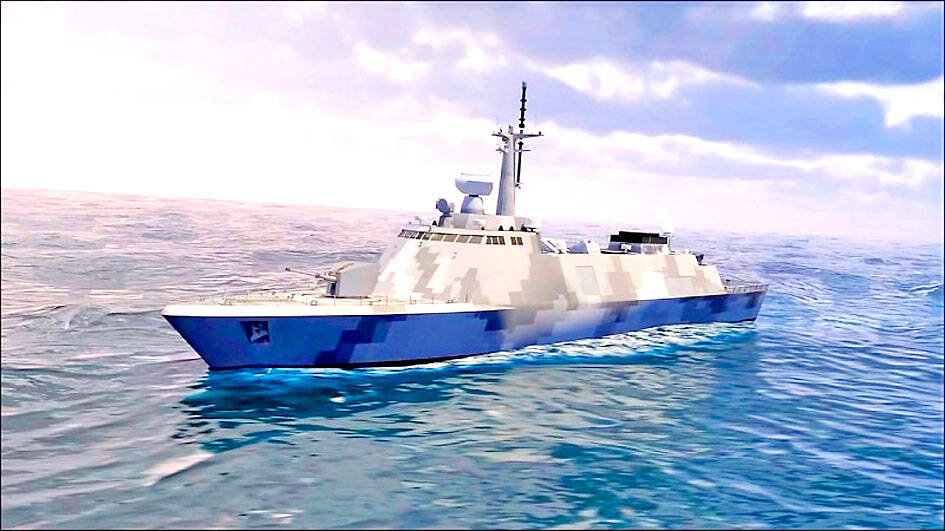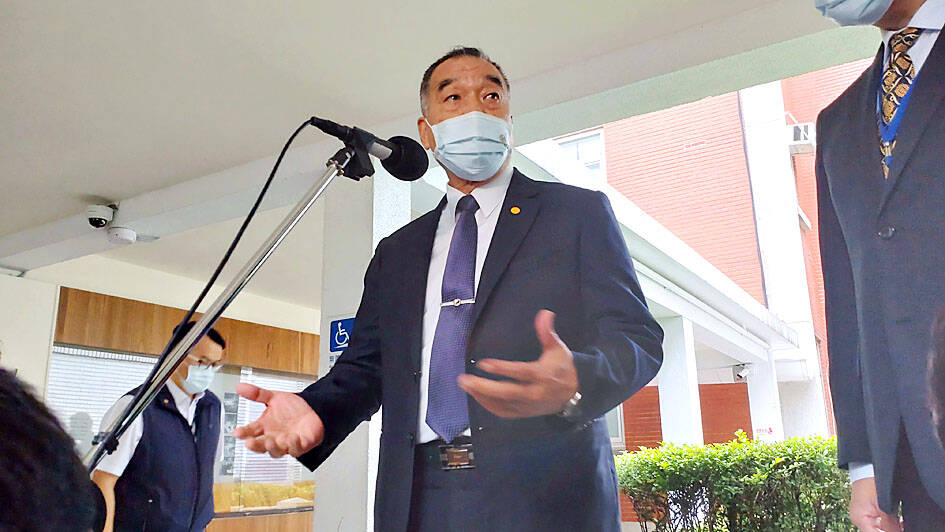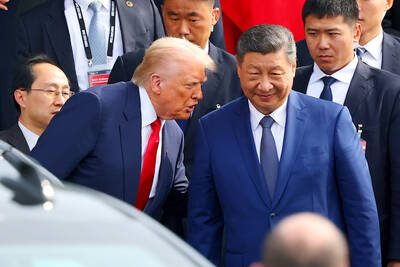A revised “Zhenhai Project” (震海計畫) would see the construction of two 2,000-tonne frigates with anti-air and anti-submarine capabilities, instead of a planned 4,500-tonne next-generation missile frigate, a budget proposal sent to the legislature yesterday by the Ministry of National Defense showed.
The streamlined plan, now named the “Naval Next-Generation Frigate Buildup Project,” would provide two ships, trading size for ease of production, the ministry said, adding that the anti-air ship is expected to enter service by 2025 and the anti-submarine ship by 2026.
The vessels would have a maximum displacement of 2,500 tonnes each, would be able to operate in winds up to level 8 on the Beaufort scale, and would be equipped with mid-range anti-air missiles, higher-range supersonic anti-ship missiles, a 76mm gun, a Phalanx close-in weapon system and depth charges or torpedoes, the budget report said.

Photo courtesy of the Chungshan Institute of Science and Technology
The ministry had initially budgeted NT$24.5 billion (US$768.8 million at the current exchange rate) from 2019 to 2026 for the project, but said it no longer addresses the navy’s needs following multiple delays.
Chinese Type 056 Jiangdao-class (江島) corvettes and a Type 053H3 Jiangwei-class (江衛) frigate have been entering Taiwanese waters since early August.
Dispatching naval vessels to monitor intruding Chinese ships has been taking a toll on the nation’s aging fleet, the ministry said, giving as an example a 50-year-old refitted Knox-class frigate, which serves as the navy’s primary anti-submarine ship.

Photo: Yang Cheng-yu, Taipei Times
However, the legislature’s Foreign Affairs and National Defense Committee expressed concern about the project’s execution and is to hear a briefing on it from the ministry today.
Work on a prototype anti-air frigate is scheduled to begin in May next year and the first phase of construction is expected to be completed by the first quarter of 2024, the budget proposal said.
The vessel would be launched by the fourth quarter of 2024 and delivered to the navy by the third quarter of 2025, it said.
Work on a prototype of the anti-submarine frigate is expected to begin in April 2025 and the initial phase of construction is scheduled to be completed by the fourth quarter of that year, the proposal said.
The ship would be launched in the fourth quarter of 2025 and delivered to the navy by the second quarter of 2026, it said.
Separately, Minister of National Defense Chiu Kuo-cheng (邱國正) told lawmakers that frequent Chinese drone incursions into Taiwan’s air defense identification zone are causing stress to the point that Taiwan might consider such incursions a “first strike.”
China’s military exercises have done away with unspoken accords between the two sides of the Taiwan Strait and contributed to heightened risk of a war, Chiu said.

CALL FOR SUPPORT: President William Lai called on lawmakers across party lines to ensure the livelihood of Taiwanese and that national security is protected President William Lai (賴清德) yesterday called for bipartisan support for Taiwan’s investment in self-defense capabilities at the christening and launch of two coast guard vessels at CSBC Corp, Taiwan’s (台灣國際造船) shipyard in Kaohsiung. The Taipei (台北) is the fourth and final ship of the Chiayi-class offshore patrol vessels, and the Siraya (西拉雅) is the Coast Guard Administration’s (CGA) first-ever ocean patrol vessel, the government said. The Taipei is the fourth and final ship of the Chiayi-class offshore patrol vessels with a displacement of about 4,000 tonnes, Lai said. This ship class was ordered as a result of former president Tsai Ing-wen’s (蔡英文) 2018

UKRAINE, NVIDIA: The US leader said the subject of Russia’s war had come up ‘very strongly,’ while Jenson Huang was hoping that the conversation was good Chinese President Xi Jinping (習近平) and US President Donald Trump had differing takes following their meeting in Busan, South Korea, yesterday. Xi said that the two sides should complete follow-up work as soon as possible to deliver tangible results that would provide “peace of mind” to China, the US and the rest of the world, while Trump hailed the “great success” of the talks. The two discussed trade, including a deal to reduce tariffs slapped on China for its role in the fentanyl trade, as well as cooperation in ending the war in Ukraine, among other issues, but they did not mention

Japanese Prime Minister Sanae Takaichi yesterday lavished US President Donald Trump with praise and vows of a “golden age” of ties on his visit to Tokyo, before inking a deal with Washington aimed at securing critical minerals. Takaichi — Japan’s first female prime minister — pulled out all the stops for Trump in her opening test on the international stage and even announced that she would nominate him for a Nobel Peace Prize, the White House said. Trump has become increasingly focused on the Nobel since his return to power in January and claims to have ended several conflicts around the world,

GLOBAL PROJECT: Underseas cables ‘are the nervous system of democratic connectivity,’ which is under stress, Member of the European Parliament Rihards Kols said The government yesterday launched an initiative to promote global cooperation on improved security of undersea cables, following reported disruptions of such cables near Taiwan and around the world. The Management Initiative on International Undersea Cables aims to “bring together stakeholders, align standards, promote best practices and turn shared concerns into beneficial cooperation,” Minister of Foreign Affairs Lin Chia-lung (林佳龍) said at a seminar in Taipei. The project would be known as “RISK,” an acronym for risk mitigation, information sharing, systemic reform and knowledge building, he said at the seminar, titled “Taiwan-Europe Subsea Cable Security Cooperation Forum.” Taiwan sits at a vital junction on